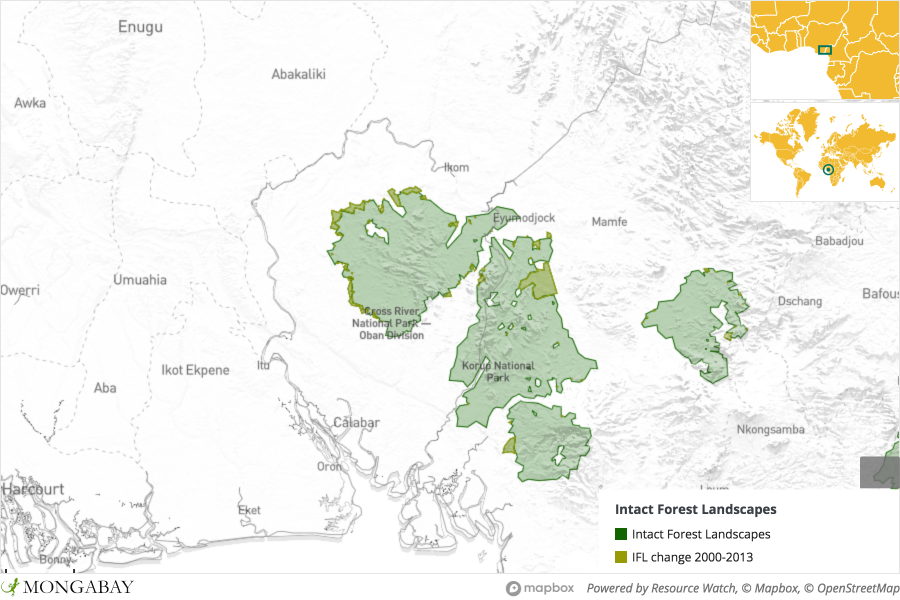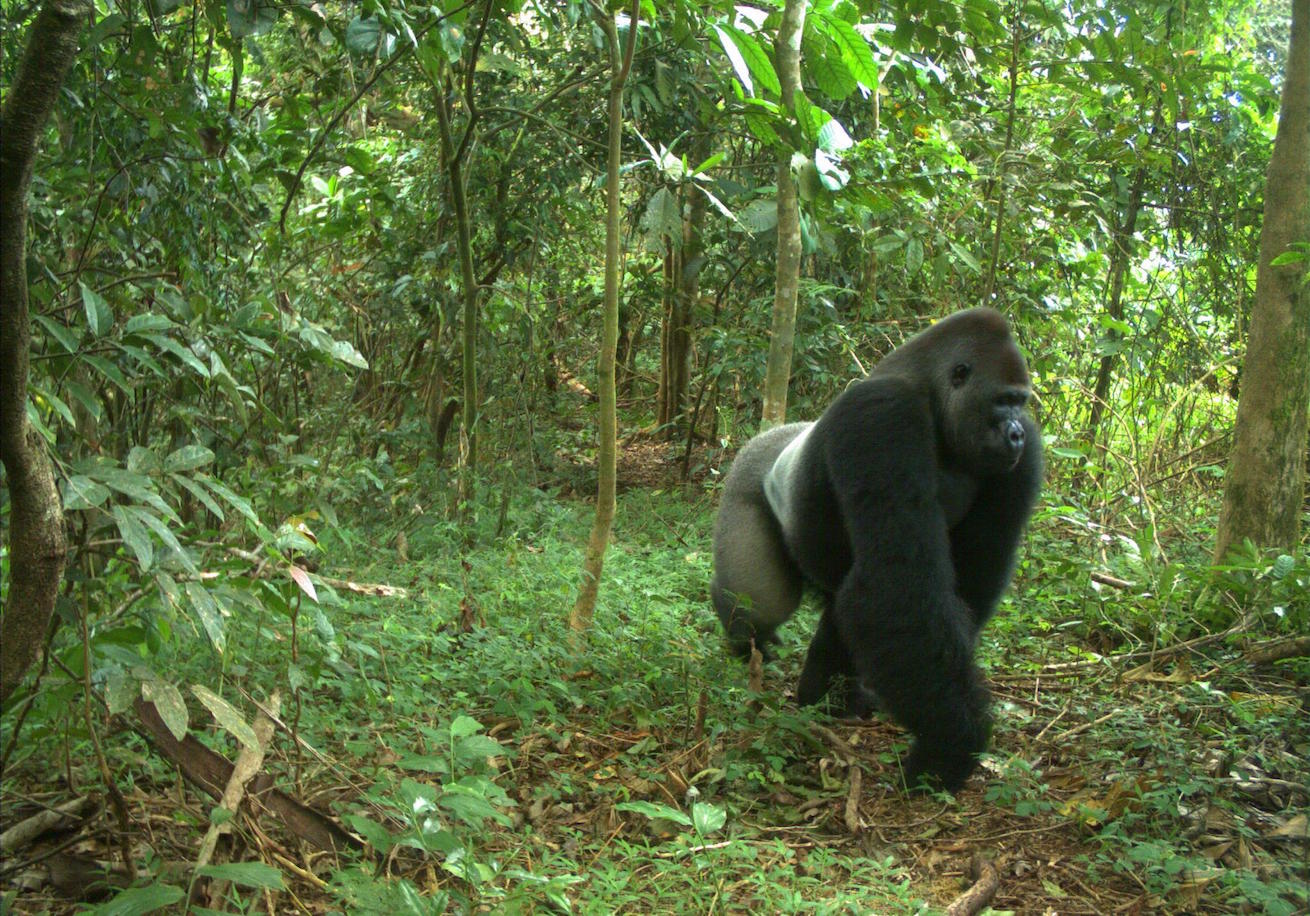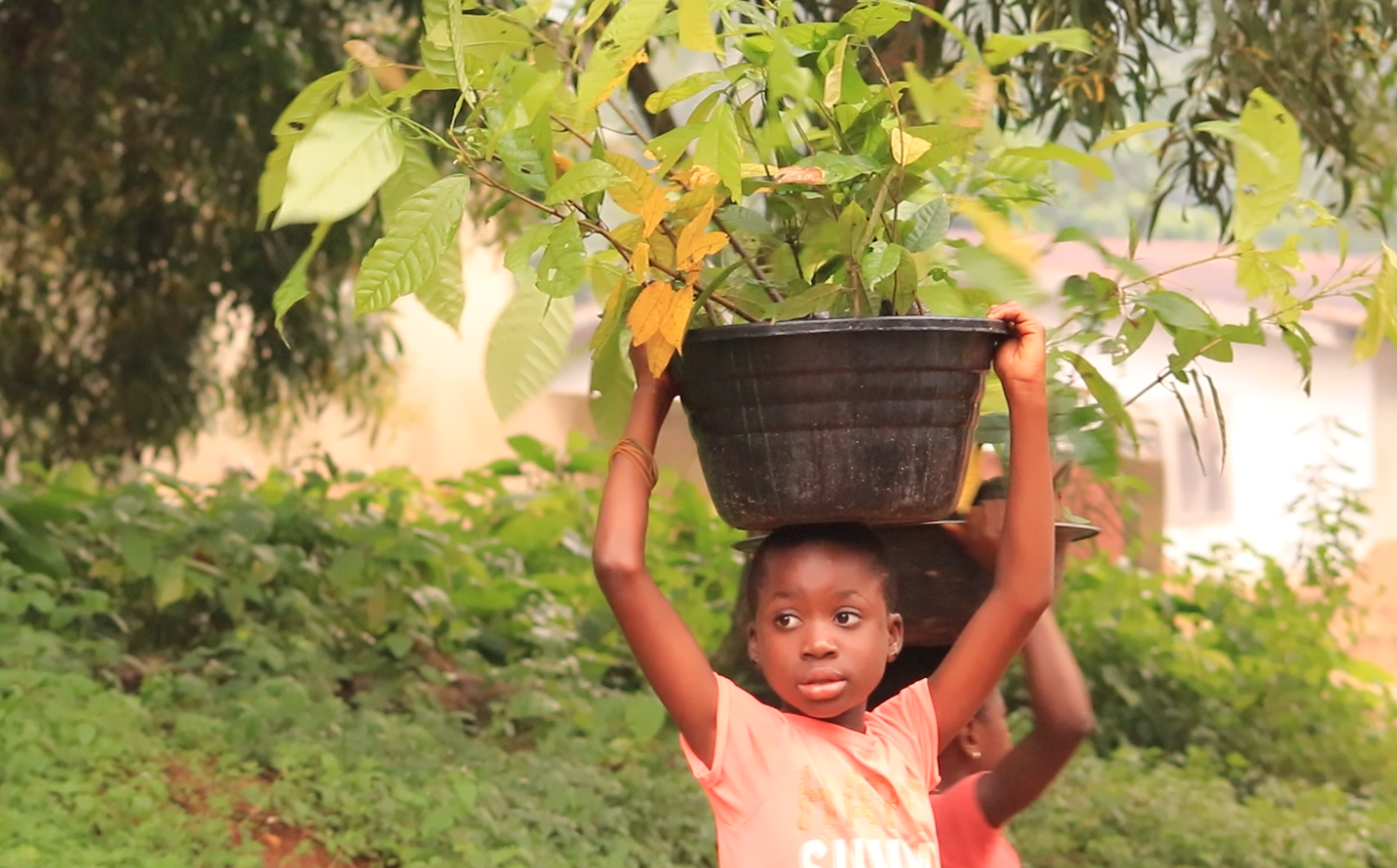- In this analysis, Mongabay contributor Orji Sunday reflects on conversations with people living in and around Nigeria’s Cross River National Park, established in 1991 to protect Cross River gorillas and other threatened species.
- For many people in the area, conservation, whether under British colonial rule or since independence, has been experienced as a loss of autonomy and livelihood, and as a string of broken promises of prosperity.
- With few alternatives and a growing population, people describe becoming ever more dependent on forests and wildlife to survive, regardless of their personal feelings about conservation and apes.
- Well-designed and monitored alternative livelihood initiatives show some chances of success, but scaling them up, and consistently monitoring them, remain challenging.
Early February 1989. A blue helicopter, partly tinted in green and white, emerged from the clouds of Kanyang, in Nigeria’s Cross River state. Gabriel Osanja, then 22, stood among the crowd peering up. The night before, as he tarried in thoughts at the fireside, a moment like this had seemed remote, even dreamy.
And yet, when he found himself within arm’s length of Prince Philip, the duke of Edinburgh, Osanja’s emotions froze. His peers in school, lining both sides of a walkway, received Philip with loud cheers, but Osanja managed only a wave of his hand and a salute. The simply dressed duke, Osanja recalls, walked lightly through the crowd. His oration was pointed and reticent, punctuated with high praise for the locals for their genial reception.
Though emotions fizzed high in Kanyang and neighboring communities, Philip’s promise to “take the message” of what he had seen and heard” to his sender, deflated Osanja. He, like others in the crowd, had been promised instant progress upon the visit of the duke. Roads would be built, even hospitals. Schools would run on scholarships. Jobs would abound.
“They told us these promises of prosperity will be fulfilled once the duke of Edinburgh had confirmed the sighting of gorillas in the area,” Osanja tells Mongabay. “We felt that something tremendous was about to happen.” Locals lived with the illusion that Philip’s position as the president of WWF entitled him to unlock wealth with words.
Months passed. The people’s hopes and rich expectations expired. Weary of waiting, Osanja and others who shared his melancholic mood had fallen back to their worst doubts. In his mind’s eye, and with the experience of Philip’s visit at heart, for Osanja ape conservation in Cross River National Park now looks like yet another chapter in a long playbook of hypocrisy.

The riches of Cross River National Park, however, have never been in doubt. The park, established in 1991, consists of two divisions, jointly covering 4,000 square kilometers (1,545 square miles). It’s home to a variety of wildlife including Cross River gorillas (Gorilla gorilla diehli), Africa’s most endangered ape, with an estimated population of just 300 individuals.
Nigeria-Cameroon chimpanzees (Pan troglodytes ellioti), forest elephants (Loxodonta cyclotis), Preuss’s red colobus (Allochrocebus preussi), forest buffalo (Syncerus caffer), drills (Mandrillus leucophaeus), and tree pangolins (Manis tricuspis) also inhabit the park as well as nearby Afi Mountain Wildlife Sanctuary, Mbe Mountains Community Sanctuary and contiguous protected sites in neighboring Cameroon.
More than the wildlife, humans, spread across buffer zone communities, make up the larger ecosystem of the park. More than 100 villages, home to more than 75,000 people, are scattered around the park.
There’s an abundance of opinions on how to balance the survival of this large population with ape conservation. These diverse perspectives, as well as limited success and even local distrust, don’t come as a surprise to Oliver Enouh.
Enouh, who teaches forestry and wildlife resources management at the University of Calabar, says that people like Osanja, who have developed resentment toward conservation, are products of a long and complex history of land and forest management in Nigeria.
Elsewhere in Nigeria, land might signify a variety of things: class, prosperity, power. But here, where farmland, forests and rivers are communal, and provide the major and cheapest source of livelihood, land means survival.

As expected, these lands did not come easily. Kanyang’s forests and lands, according to oral history, were prizes won through dozens of communal wars during pre-colonial times. Ancient warriors in Kanyang partnered with potent oracles to conquer towns with material and spiritual ferocity. Peace-loving or conquered communities, forced by superior weaponry or upright conscience, vacated contested spaces. “These lands were gained with the blood of men and wars,” Enouh tells Mongabay. “It is inherited from the ancestors of the natives.”
As the 19th century wound down, colonial authorities coerced locals, with guns and threats, into submitting their lands and pristine forests for development and conservation purposes in various parts of Nigeria. The mantra for this policy was scientific forestry, “to keep the forest for future generations.”
The path fit a trajectory seen across the British Empire in West Africa, Enouh says. “Forests that were nationalized for conservation purposes, became commercial commodities. They [the colonialists] introduced massive industrial logging. The same whiteman who introduced Western-type conservation had undermined it,” he says.
Those who hoped independence would bring a change were bitterly disappointed; since the dawn of independence in 1960, succeeding local authorities continued along the path of reducing local control over forests and tolerating — or even promoting — the razing of forests for logging and agriculture. “The hypocrisy of the colonialists was inherited by nationalist leaders who even did the worst,” Enouh says.
Years of upheaval, including the 1967-1970 civil war, didn’t cool old anger about the loss of control over land and forests in places like Kanyang. As a result, in the late 20th century, when strict ape conservation proposals were gaining foothold, efforts to change local sentiment about conservation required not just accurate information but also the excitement of new expectations.
The visit by the duke, and the promises of prosperity that accompanied it, did enough to revive that latent elation. Kanyang endured long preparations. According to elders today, youths at the time, the lead-up to the visit was filled with repeated radio jingles, press releases and newspaper clippings that played the news with endless appetite.

A park with a promise
The duke exited Cross River state after his short visit, but Kanyang and nearby communities retained some spark. Dozens of researchers and reporters had been trying to satisfy their curiosity about the emerging gorilla hotspot.
In 1987, for instance, notable primatologist Alexander Harcourt, in the company of Kelly Stewart and Ibrahim Inahoro, conducted a gorilla population survey with support from the British Council and partners. The Harcourt-led research team had sighted gorillas in a small group and recorded nests and dung of various sizes. It was the first sighting of gorillas recorded in more than three decades.
By 1991, Cross River National Park was created. However, Kanyang was no longer a town of particular strategic interest to the park planners. It was neither an enclave community nor a lead administrative location, though it remained relevant. Osanja says his people felt sidelined from what they saw as their ordained prestige as the site of the duke’s visit. Their affection for conservation, as a result, went cold.
While Kanyang’s fame diminished, the little-known village of Okwa, one of the enclave communities inside the core of the national park, inherited all the limelight. And so did John Akwo, who was just reaching the prime of his teenage years. He was among the few there who could read and interpret the English tongue — a genius that earned him a place, at 18, in the company of wizened elders when the park proposals were publicly discussed in the village square.
“The national park came with a lot of promises,” Akwo told Mongabay. “They told us that their coming was not to kill us, but to bring an end to our suffering in due time. They said we have suffered a lot. That our thatched houses will be replaced. They promised us a road, and hospitals and schools. Everybody was excited that the messiah had come.”

The feasibility study and master plan for the park was grand. Prepared two years earlier by WWF and the U.K. government’s Overseas Development Natural Resources Institute, the plan proposed a seven-year livelihood project for adjoining and buffer zone communities. “The creation of the park resulted in over 100 buffer zone communities being stripped of their rights to forest resources exploitation in the park territory, culminating in economic contestation and park-people conflicts,” one researcher concluded.
The six enclave communities inside the national park, including Okwa, now faced a twin dilemma. The first was the impending loss of livelihood. More worryingly, however, was the proposal to resettle the enclave communities. To Akwo’s delight, the government, probably pacified by local pressure and resistance, backtracked on the resettlement agenda. In turn, a permanent pause on the livelihood programs left him in despair.
While anticipated foreign funding for livelihood programs didn’t materialize, park protection was one area that was enforced with vigor. More rangers, brought in to enforce new and stiffer regulations, curtailed the freedom of local people with their forest. There was a ban, at least, a restriction on hunting, logging and farming within the park borders. It’s estimated that more than two dozen ranger stations exist in buffer zones communities across the park.
As part of the new measures, gathering rights for non-timber forest products became severely limited. Worse still, a significant proportion of family, community and individual lands cultivated with food crops and trees had been included in the park map, despite repeated appeals and petitions.
This not only deepened local suspicions of conservation, it equally sharpened their tricks. Hunters, having mastered the secret paths and contours of the forest, the signs and movements of animals as well as food type and time, hunted at night when law enforcement was most ineffective. Nearly identical trickery was adopted for logging and the bushmeat trade. Rangers faced direct resistance in the form of protests, but also fights from the more daring communities.

Restitution in small measures
The livelihood pressure among park communities had emerged out of genuine concerns. For one, earlier conservationists, by their grand oratory and sugar-coated promises, had excited intense but temporal interest in ape conservation. They portrayed compliance with conservation laws and policies as a gateway to community and private prosperity.
In the same breath, the dependence on forest resources has deepened. Community and family lands diminished in size and fertility. The forest lands, still rich in fertility, became a cheap and tempting option for a restless, jobless and poor youthful population in and around the national park.
At different points in their histories, these buffer communities were a target of a variety of livelihood initiatives by government and NGOs. However, not many locals effectively functioned in these diverse income-substitute programs. There were defunct goat- and pig-farming initiatives. Some households received grants to support beekeeping and snail farming to subsidize household protein needs.
The logic behind some of these initiatives were solid, locals told Mongabay, but poor execution and monitoring connived to stifle long-term success and sustainability.
These days, some efforts are being made to rectify old errors.

When Juliet Ntui, socioeconomic coordinator of the Wildlife Conservation Society (WCS) in Cross River, and her team designed the organization’s latest livelihood intervention, they were careful to avoid previous pitfalls. Attention has turned to cocoa farming, the local peoples’ chief crop and a major driver of forest clearing in protected areas. The program combines training to strengthen competence and skills with the implementation of a fortified system of monitoring to ascertain compliance and growth.
One clear evening in early August, Ntui and her team were distributing free cocoa seedlings to farmers in Abo-Obisu, one of the buffer communities near the Mbe Mountains Community Sanctuary, home to nearly half of all gorillas in Nigeria. “Listen, my people. Please listen carefully” Juliet shouted, above a crowd that drowned her out with their murmuring and chattering. “The seedlings you have received are only for old farms. Do not clear new farms inside the protected area. We do not intend to encourage deforestation.”
WCS had already trained participating farmers on how to revive old farms, to contain the temptation of planting the seeds in newly cleared forest lands in the protected areas. The new seeds matured quicker, offered more generous yields and resisted diseases more firmly. With GPS mapping, WCS monitored all farms, to ensure seedlings were not used illegally.
Farmers also signed a conservation agreement that compelled each to comply with regular monitoring exercises to prevent new deforestation and empowered WCS to take action against offenders. Started in 2017, the program also offers lessons on savings, networking and access to more profitable markets for their harvest. On March 10, the program received a boost when the European Union donated 2 million euros ($2.2 million) primarily to expand and maintain sustainable livelihoods for communities that share the habitat of gorillas.
Ntui says she’s satisfied with the solid logic behind the project and the ratings it has received from locals, but adds she’s worried about the scale. During the seedling distribution, the turnout was overwhelming, with each farmer receiving around 150 seedlings. So far, more than two dozen communities have been reached. But only a fraction of eligible farmers receive the seedling support.
“We keep creating awareness but it’s also about realizing that more people are depending on this land and the land doesn’t expand,” she tells Mongabay. “I can’t overemphasize the need to expand and improve livelihood intervention.”

When love is not enough
Before sunset, Ntui had a low-tuned chat with the woman leader of a WCS-backed cooperative that saves and trades bush mangoes. They spoke about the women’s progress with their savings and the seasonal bush mango gathering. After three hours of steady engagement, her countenance had lost some charm. Her lips now moved slowly when she addressed new questions, but her dark eyes, hidden behind a nude-colored cap, retained their radiance.
Ntui was greeted with warmth and enthusiasm throughout her trip. Children huddled around her, tripping over themselves to make it to her grasp. She had impromptu photo shoots with them and laughed hard at their awkward posing.
But despite this affection for individual conservation workers, Cyprian Osang, a teacher in Wula-Mgbaeshuo, says hunger, poverty and unemployment push families to turn to the forests to survive. Low wages, absence of social welfare support and lack of pensions for the retired further exacerbate the pressures on households.
After 18 years of teaching primary school, Osang, who is among the wealthiest civil servants in the entire village, earns less than 70,000 naira ($169) monthly. But that is far less than what his nuclear family of six and extended relatives need to survive. “The forest becomes the last resort” and the peoples’ insurance in times of urgent crisis, he says. He admits to trapping and farming to support his inadequate income in desperate times.
Researchers like Enouh contemplate a multipronged solution to the conservation concerns in Cross River. Some have proposed greater investment in tourism, increased funding for forestry commission as well wider community consultation while designing livelihood programs. Enouh agrees with their perspectives but concludes that all these factors depend on strong will from the government. Great turnaround, he says, might only become manifest when the government stops looking to profit only but puts people at the center of its approach to forestry management and services.

Related audio from Mongabay’s podcast: Gorilla Radio is a radio program aimed at helping raise awareness of critically endangered gorillas in Nigeria, listen here:
FEEDBACK: Use this form to send a message to the author of this post. If you want to post a public comment, you can do that at the bottom of the page.
